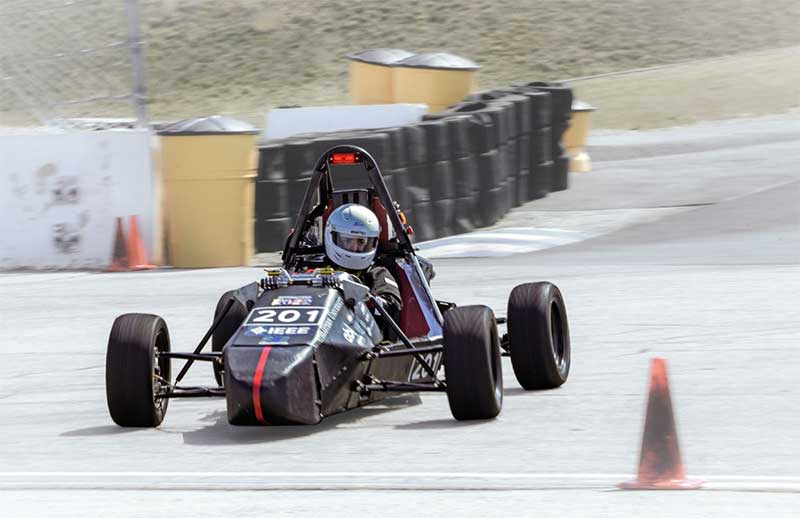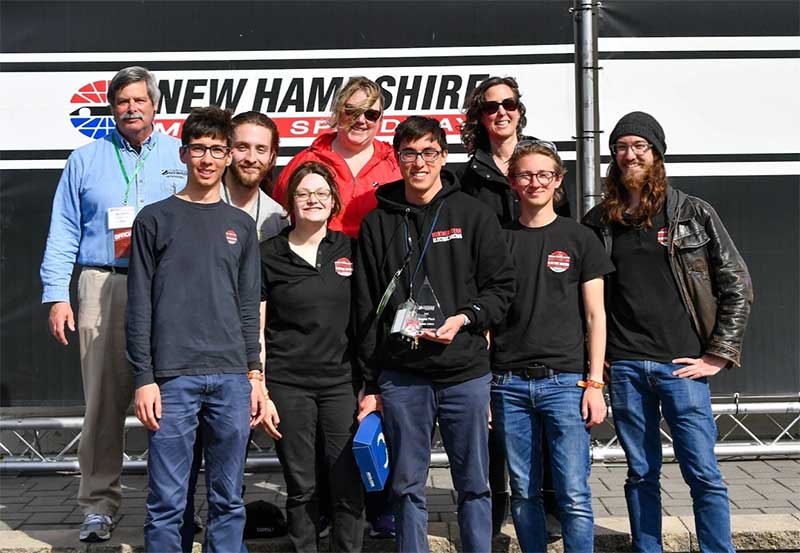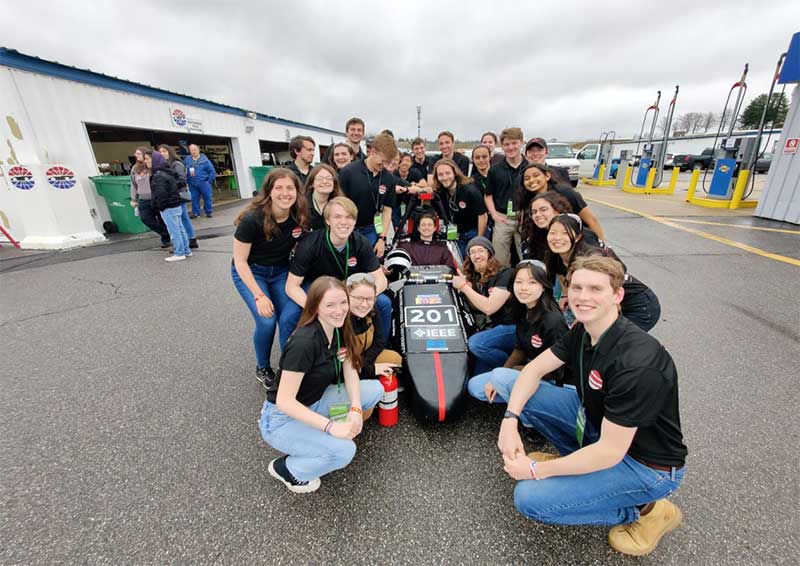At New Hampshire’s “Magic Mile,” software and engineering drive Northeastern success
Author: Madelaine Millar
Date: 09.19.22
James Chang-Davidson flew down the New Hampshire Motor Speedway. His formula-E-style race car, meticulously engineered for five long years and nicknamed “Cinnamon”, bumped and jittered underneath him but continued to zip. Flooring the accelerator, Chang-Davidson pushed Cinnamon, dashing across the finish line at 60 mph.
 NER’s drivetrain lead Sofia Varner takes the wheel.
NER’s drivetrain lead Sofia Varner takes the wheel.
“The car rides about an inch off the ground so you’re really low, and the open cockpit means you are seeing everything going by; if you had your visor up the wind would be hitting your face really hard. And then you’re holding the steering wheel — there’s no power steering — so you’re feeling every little bump in the road,” Chang-Davidson said. “I’m not a huge roller coaster guy, but this was the best roller coaster-like experience I have ever had.”
Chang-Davidson is the president of Northeastern Electric Racing (NER), a campus club that brings together software, mechanical, and electrical engineers; project managers; and business students to build an all-electric formula-style car. The 170-student team first raced at Formula Hybrid+Electric in May, placing second out of 14 teams in the electric category — a hair’s breadth behind powerhouse Carnegie Mellon University — and nabbing the prestigious Scrutineers’ Award for their exhaustive documentation.
“It’s taken us about five years, with a lot of mistakes along the way — working through the pandemic, working through the challenges of establishing a new student group with its own culture and its own set of interdisciplinary work,” said Chang-Davidson, a fourth-year CS major. “It’s a very long journey culminating in going to competition with the university’s first ever all-electric formula-style race car. We were so proud.”
Ready, Software, Go
For Nicholas DePatie, the motivation is simple: “I like making the car go fast.”
DePatie, a third-year electrical and computer engineering major, heads NER’s data and controls system, ensuring the software systems embedded in the car itself are working optimally. When the driver presses a pedal, DePatie and his team ensure the pedal’s signal transverses the car’s network to reach its microcontroller, combines correctly with readings from the other sensors, converts into a torque value, and tells the motor controller to accelerate the car.
Acceleration: 0 to 60 in six seconds
Weight: 780 lbs
Battery: 3.6 kWh
Battery Cells: Samsung 18650 Li-ion
“I can physically see the car working in real time, and I can see the car running well with nothing breaking,” DePatie said. “I think that is very, very rewarding.”
A lot of DePatie’s effort has gone into building a custom battery management system, called Shepherd BMS, that monitors the battery’s temperature and makes minute adjustments so the battery doesn’t get too hot. DePatie and his team spent months designing the system and the printed circuit board, and are now working through application control code, firmware, and system testing.
Now that Shepherd BMS is up and running, DePatie wants to try adding machine learning to the system. The telemetry data the team has collected will help them train an algorithm to use the batteries’ temperature, charge cycles, and current voltage to calculate their state of charge, making Shepherd BMS more accurate. The Shepherd BMS work is sponsored by ABL Space Systems, where DePatie’s predecessor Nicholas Velcea now works as an avionics engineer.
Other than working on a project he cares about, what keeps DePatie coming back to NER is the people.
“A lot of people are dedicated to making the best car possible,” he said. “It’s nice, because everyone has different specialties and everyone has different depths of knowledge in certain topics. It’s never really assumed that one person doesn’t know as much as another; we just assume that everyone knows their own stuff.”
Crossing the FinishLine
For third-year CS and design major Leroy Shaigorodsky and fourth-year CS and linguistics major Anthony Bernardi, the race car is a cool feature of NER, but not the main draw. Instead, what drew them was the chance to explore web development and product management skills with a supportive group of engineers and computer scientists.
As the head of software product management and head of software solutions respectively, Shaigorodsky and Bernardi are creating a project management software platform called FinishLine to ensure that the “building” part of “building a car” runs smoothly. FinishLine allows NER’s 11 team heads to break down their system into projects, then into steps that can be tracked and coordinated with other teams — replacing the collection of intermittently updated spreadsheets that marked the club’s early days. They first deployed the platform this summer, and are now refining the user experience and adding features like financial management, with the goal of giving club members experience with startup-style structure and processes.
 James Chang-Davidson (center front) and a few of his teammates pose with the inaugural Scrutineers’ Award, given in memory of trailblazing Formula One scrutineer Suzanne Royce.
James Chang-Davidson (center front) and a few of his teammates pose with the inaugural Scrutineers’ Award, given in memory of trailblazing Formula One scrutineer Suzanne Royce.
“I think the biggest problem to solve was the accessibility of information throughout the club,” Bernardi said. “We wanted anyone who’s an engineer to be able to go into FinishLine and look at the projects.”
Applying his concentration in experiential design to FinishLine has been a particular treat for Shaigorodsky.
“There are a lot of different skills and specializations you can get into and try out at NER,” he said. “If you want to learn web dev, it’s a great place to learn web dev. If you’re trying to diversify and get product management experience, we have a whole process to get people into that. You can make it what you put into it.”
While Electric Racing might have the most draw for mechanical and electrical engineers, both Shaigorodsky and Bernardi encouraged computer scientists interested in web dev or project management to explore NER.
“It’s cool that they build a car and drive it and do really well in competition; it’s crazy to me. But for me, I actually just really enjoy coding and learning,” Bernardi said. “NER was a very inclusive environment. It doesn’t matter where you start, as long as you’re committed to learning.”
Racing On
With Cinnamon in full working order and detailed documentation ready to go, Chang-Davidson and a group of his NER teammates packed up for Loudon, New Hampshire for the car’s debut race. NER set their sights on simply passing Formula Hybrid+Electric’s technical inspection that preceded the three time trials: a 75-meter acceleration test, a 44-kilometer endurance test, and an autocross event to test maneuverability. They were so technically oriented that they didn’t think to train dedicated drivers.
“We hadn’t put a lot of effort into the race strategy component — who’s gonna race, making sure they have hours and hours of practice on a simulator, and that sort of thing,” Chang-Davidson said. But as the technical inspection progressed, “we realized very quickly that we were neck and neck with the first-place team. We were passing technical inspections faster than anticipated and our car was performing quite well in comparison. We were really thrilled.”

Six volunteers stepped up to take the wheel: engineering students Sofia Varner, James Blatcher, Casey Sauer, Matthew McCauley, and Jakob Rauen, plus Chang-Davidson himself. As the team competed, industry judges from Tesla and General Motors gave feedback on the car’s design. They showed the team where Cinnamon was severely over-engineered, where NER could improve the steering and battery management system, and how to cut down on weight.
NER plans to fine-tune and compete their existing car at Formula Hybrid+Electric next year. At the same time, Chang-Davidson and his teammates are excited to spend the next two years building an entirely new car using the feedback they’ve received on the current model. They plan to compete the new car at Formula SAE in Michigan, a significantly larger and older competition than Formula Hybrid+Electric.
Bernardi is excited about the work to come, but he’s equally excited about who he will be working with.
“NER is a network of friends you can make — we’re all committed to this type of thing, and you learn a lot of very useful and marketable skills,” he said. “There’s not a lot of places where you can build a car; I just think it’s a really cool place in the community.”
Subscribe to the Khoury College newsletter
The Khoury Network: Be in the know
Subscribe now to our monthly newsletter for the latest stories and achievements of our students and faculty